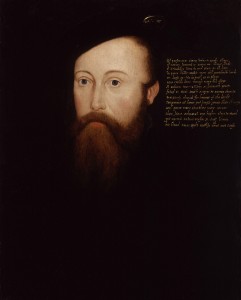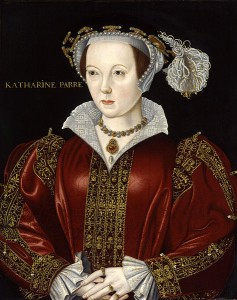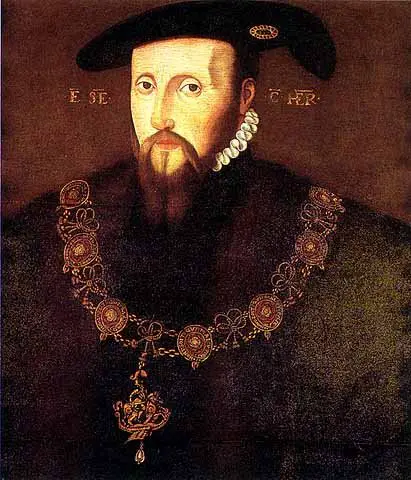 Thomas Seymour, 1st Baron Seymour of Sudeley, was born in or before 1509 and was the fourth son of Sir John Seymour and his wife Margery Wentworth. He would have grown up at the Seymour family home of Wolf Hall (also known as Wulfhall) in Wiltshire. He was one of a brood of six sons and four daughters, and his siblings included Edward Seymour, Lord Protector; Jane Seymour, Henry VIII's third wife and queen consort; Elizabeth Seymour, who married three times: Sir Anthony Ughtred, Gregory Cromwell and John Paulet; and Sir Henry Seymour.
Thomas Seymour, 1st Baron Seymour of Sudeley, was born in or before 1509 and was the fourth son of Sir John Seymour and his wife Margery Wentworth. He would have grown up at the Seymour family home of Wolf Hall (also known as Wulfhall) in Wiltshire. He was one of a brood of six sons and four daughters, and his siblings included Edward Seymour, Lord Protector; Jane Seymour, Henry VIII's third wife and queen consort; Elizabeth Seymour, who married three times: Sir Anthony Ughtred, Gregory Cromwell and John Paulet; and Sir Henry Seymour.
Nothing is known of his early life, but Thomas started his court career by serving courtier and diplomat, Sir Francis Bryan, in whose service he was in by 1530. The Seymour family began to rise in favour at Henry VIII's court as the king started courting Jane Seymour in spring 1536 and then married her on 30th May 1536, following the execution of Queen Anne Boleyn. Thomas joined Henry VIII's privy chamber in October 1536 and while his sister was queen his rewards included being knighted and being named joint master steward of Chirk and Holt. In 1538, he benefited from the dissolution of the monasteries by receiving land once owned by monasteries in Essex, Hampshire and Berkshire. He was involved in diplomatic missions to France, Vienna and the Low Countries in 1538, 1542 and 1543 respectively.
In 1543, he was made marshal of the English army in the Low Countries and then master of the ordnance for life in April 1544. He was involved in the capture and destruction of the castles at Rinquecen and Arbrittayne, in France, near Boulogne, and then Boulogne itself. In October 1544, he was made an admiral of the fleet, and in November 1544 he was given Hampton Place in London, which he renamed Seymour Place.
In 1538 and again in 1546, Thomas Howard, 3rd Duke of Norfolk, put forward the idea of a marriage between Seymour and Norfolk's daughter, Mary, widow of Henry Fitzroy, Duke of Richmond and Somerset. Mary's brother, Henry Howard, Earl of Surrey, was against the match, and the idea came to nothing. Seymour appears to have been courting Catherine Parr, widow of John Neville, 3rd Baron Latimer, but the relationship was brought to an end when Henry VIII became interested in her and subsequently married her in July 1543.
In January 1547, Seymour was appointed to Henry VIII's privy council and then named as an executor in the dying king's will. Henry VIII died on 28th January 1547 and although the king had planned for a regency council of equals, those he'd named as executors, to advise his nine-year-old-son, Edward VI, Seymour's brother, Edward, became Lord Protector. Thomas Seymour was created Baron Seymour of Sudeley on 16th February 1547, Lord High Amdiral on 17th February and was also elected to the Order of the Garter that year. He also secretly married Catherine Parr, who was now the dowager queen around May 1547 and the couple lived together at Chelsea with Seymour's ward, Lady Jane Grey, and Catherine's stepdaughter, Elizabeth, daughter of Henry VIII and Anne Boleyn. Catherine quickly became pregnant and it seems that Thomas Seymour's attentions turned to the fourteen-year-old Elizabeth. Kat Ashley described Thomas Seymour's behaviour towards Elizabeth:"Incontinent after he was married to the Queene, he wold come many mornings into the said Lady Elizabeth’s Chamber, before she was redy, and sometimes before she did rise. And if she were up, he would bid hir good morrow, and ax how she did, and strike hir upon the Bak or on the Buttocks famylearly, and so go forth through his lodgings; and sometimes go through to the Maydens, and play with them, and so go forth: And if she were in hyr Bed, he wold put open the Curteyns, and bid hir good morrow, and make as though he wold come at hir: And she wold go further in the Bed, so that he could not come at hir."
It did not stop there. Kat Ashley also had to reprimand Seymour on one occasion for getting into bed with Elizabeth and he later started visiting Elizabeth dressed only "in his Night-Gown, barelegged in his slippers". Catherine seems to have seen the behaviour as innocent horseplay and even joined in on occasions, even holding her stepdaughter while Seymour slashed at her gown with a dagger. Catherine eventually did take action, after finding her husband and Elizabeth in an embrace, and she sent her stepdaughter to go and live with her good friends, Sir Anthony Denny and his wife at Cheshunt in May 1548. In June 1548, Thomas Seymour and Catherine moved to Sudeley Castle in Gloucestershire and on 30th August 1548 Catherine gave birth to their daughter, Mary. Catherine died, probably of puerperal fever, on 5th September 1548.
By this time, Seymour was a very dissatisfied man. He had seen his brother, Edward, rise to power as Lord Protector and his brother had seized Catherine Parr's jewels, and the Lord Protector and his wife had snubbed Thomas and Catherine. Without Catherine’s steadying influence, Thomas Seymour began a campaign to undermine his brother and loosen his hold on their nephew, Edward VI. An informant told Seymour that the young king often complained about his lack of pocket money, so Seymour wormed his way into Edward's affections by smuggling money to him. He also set out to damage his brother's reputation by voicing his concerns over the way that Somerset was running the country, and he undermined his brother's control by using his position as Lord High Admiral of the English Navy to encourage piracy, something he was meant to stamp out.
Seymour was also bribing Sir William Sharington, vice-treasurer of the Bristol Mint, who Seymour learned had been fiddling the books. This was the perfect opportunity for Seymour to get financing for a coup against his brother's protectorship, but it all went pear-shaped when the privy council learned of Seymours plans at the end of 1548. Seymour was called to appear before the council to explain himself but in desperation he hatched a plot to kidnap Edward VI.
On 16th January 1549, it is said that Thomas Seymour broke into the king' apartments at Hampton Court Palace by entering through the privy garden. As he entered the apartments, the king's spaniel woke up and barked. Seymour is recorded as shooting the dog. The shot alerted a guard who confronted Seymour and Seymour was arrested and taken to the Tower of London. Not only was Seymour then accused of trying to kidnap the king, he was also accused of plotting to marry the king's half-sister, Elizabeth, and attempting to put her on the throne. He was accused of thirty-three separate accounts of treason.
 Following Seymour's arrest, Elizabeth was interrogated about her relationship with him, and her servants, Thomas Parry and Katherine (Kat) Ashley, were detained at the Tower. Sir Robert Tyrwhitt was the man in charge of questioning Elizabeth, Parry and Ashley and he had no sympathy for Thomas Seymour. Tyrwhitt, like everyone else, had heard rumours of some kind of relationship between Seymour and Elizabeth and was looking for confirmation. Elizabeth kept her cool and all Tyrwhitt was able to get out of the teenager was confirmation that there was indeed gossip circulating that Seymour was looking to marry her and that he had been asking about her finances and estates. Despite the threats that were almost certainly used against her, and the fact that she was told that Parry had told everything, Elizabeth insisted that she would "never... marry, neither in England nor out of England, without the consent of the king's majesty, your grace's [Somerset], and the council's", according to the terms of her father's will. Tyrwhitt had no evidence against Elizabeth and although her servants continued to be detained until shortly before Seymour's execution in March 1549, Elizabeth was in the clear.
Following Seymour's arrest, Elizabeth was interrogated about her relationship with him, and her servants, Thomas Parry and Katherine (Kat) Ashley, were detained at the Tower. Sir Robert Tyrwhitt was the man in charge of questioning Elizabeth, Parry and Ashley and he had no sympathy for Thomas Seymour. Tyrwhitt, like everyone else, had heard rumours of some kind of relationship between Seymour and Elizabeth and was looking for confirmation. Elizabeth kept her cool and all Tyrwhitt was able to get out of the teenager was confirmation that there was indeed gossip circulating that Seymour was looking to marry her and that he had been asking about her finances and estates. Despite the threats that were almost certainly used against her, and the fact that she was told that Parry had told everything, Elizabeth insisted that she would "never... marry, neither in England nor out of England, without the consent of the king's majesty, your grace's [Somerset], and the council's", according to the terms of her father's will. Tyrwhitt had no evidence against Elizabeth and although her servants continued to be detained until shortly before Seymour's execution in March 1549, Elizabeth was in the clear.
On 25th February 1549, a bill of attainder was introduced into Parliament and lawyers argued that Seymour's offences "were in the compasse of High Treason". The bill was passed on 5th March and Thomas Seymour was executed on Tower Hill on the 20th March 1549. His young nephew, the king, signed his death warrant.
Here is an extract from On This Day in Tudor History about his execution...
During his imprisonment in the Tower of London, Thomas Seymour wrote the following poem:
“Forgetting God
to love a king
Hath been my rod
Or else nothing:
In this frail life
being a blast
of care and strife
till in be past.
Yet God did call
me in my pride
lest I should fall
and from him slide
for whom loves he
and not correct
that they may be
of his elect.
The death haste thee
thou shalt me gain
Immortally
with him to reign
Who send the king
Like years as noye
In governing
His realm in joy
And after this
frail life such grace
As in his bliss
he may have place."
Seymour's execution was highly unpopular, and the king's council had to take steps to calm the situation by blackening Seymour's name. The council spread it around that Seymour had written letters to Mary and Elizabeth encouraging them to rise up against their brother's government, and Hugh Latimer, the cleric who had been friends with Seymour, and who had had Seymour as his patron, preached a sermon vilifying him, and accusing him of being an atheist, traitor and debaucher of women:
"He was, I heard say, a covetous man:... I would there were no more in England. He was, I heard say, an ambitious man: I would there were no more in England. He was, I heard say, a seditious man, a contemner of common prayer: I would there were no more in England. Well he is gone. I would he had left none behind him. As touching the kind of his death, whether he be saved or no, I refer that to God only… And when a man hath two strokes of the axe who can tell but that between two strokes he doth repent? It is very hard to judge. Well, I will not go so nigh to work; but this I will say if they ask me what I think of his death, that he died very dangerously, irksomely, horribly... He was a man the farthest from the fear of God that I knew of or heard of in England... surely he was a wicked man and the realm is well rid of him."
Nicholas Throckmorton said of Seymour's end:
"Off went his head, they made a quick despatch,
But ever since I thought him sure a beast
Who causeless laboured to defile his nest
Though guiltless, he, through malice, went to pot
Not answering for himself nor knowing cause."
John Harington, Seymour's servant and friend, wrote of Seymour:
"Friend to God’s truth, and foe to Rome's deceit...
Yet against nature, reason and just laws
His blood was spilt, guiltless, without just cause."
It is alleged that the fifteen-year-old Elizabeth, on hearing of Seymour's death, said: "This day died a man of much wit and very little judgement".
Thomas Seymour was buried at the Tower of London, in the Chapel of St Peter ad Vincula.
More resources on Thomas Seymour:
- Thomas Seymour and Elizabeth: A Claire Chats video
- 16 January 1549 - Thomas Seymour tries to kidnap Edward VI
- Thomas Seymour Quiz
Notes and Sources
- Bernard, G. W.. “Seymour, Thomas, Baron Seymour of Sudeley (b. in or before 1509, d. 1549).” G. W. Bernard In Oxford Dictionary of National Biography, edited by H. C. G. Matthew and Brian Harrison. Oxford: OUP, 2004. http://www.oxforddnb.com/view/article/25181
- The Elizabeth Files website, Claire Ridgway
- Ridgway, Claire (2012) On This Day in Tudor History, MadeGlobal Publishing.
- John Harington, Nugae Antiquae (London, 1769), vol. 3, p259, quoted in Katherine the Queen by Linda Porter (2010), Macmilliam, p338.




Hugh Latimer defended Sir William Sharington (aka Sherrington) knighted at young King Edward’s coronation. William, of Lac*ck Abbey was also held and tortured alongside Seymour who of course lost his head. William was favoured by Henry VIII who placed him in charge of the Royal Mint at Bristol where he had ships and imported woollens for the industry in Lac*ck. His Northern family cousins were Francis, Gilbert, and James, all Mayors and Burgesses of Wigan. They were also members of the Guilds in London and their marriages etc. were held at St. Dionysius Backchurch where another brother also William was a leading cloth merchant and a Freeman of the Guilds of Fishmongers and Haberdashers. Sir William Sharington was already making Testoons for Henry VIII by debasing the silver mixing other metals mainly in order to pay the army in Ireland. The Sherringtons were also known as Pewterers so no surprise as to how Henry got the idea. It seems to follow that when his close friendship with Thomas Seymour was developing they planned to produce more of these coins to pay an army “for one month” when plotting to take over his brother’s role as Protector. King Edward got pocket money as was said from Thomas and as William was the Treasurer at the Bristol Mint no doubt the source wasn’t difficult to trace. As Sir William had been Master of the Robes under Henry he would have been well acquainted with young Edward when he was the Prince. I am sure that is why he got away with his life while Thomas got the chop ! Parliament did fine him £12,000 but he got his lands etc. back and lived on into the reign of Elizabeth. I am a descendant of the Sherringtons, thus my interest in, like Latimer, in defending his honour !